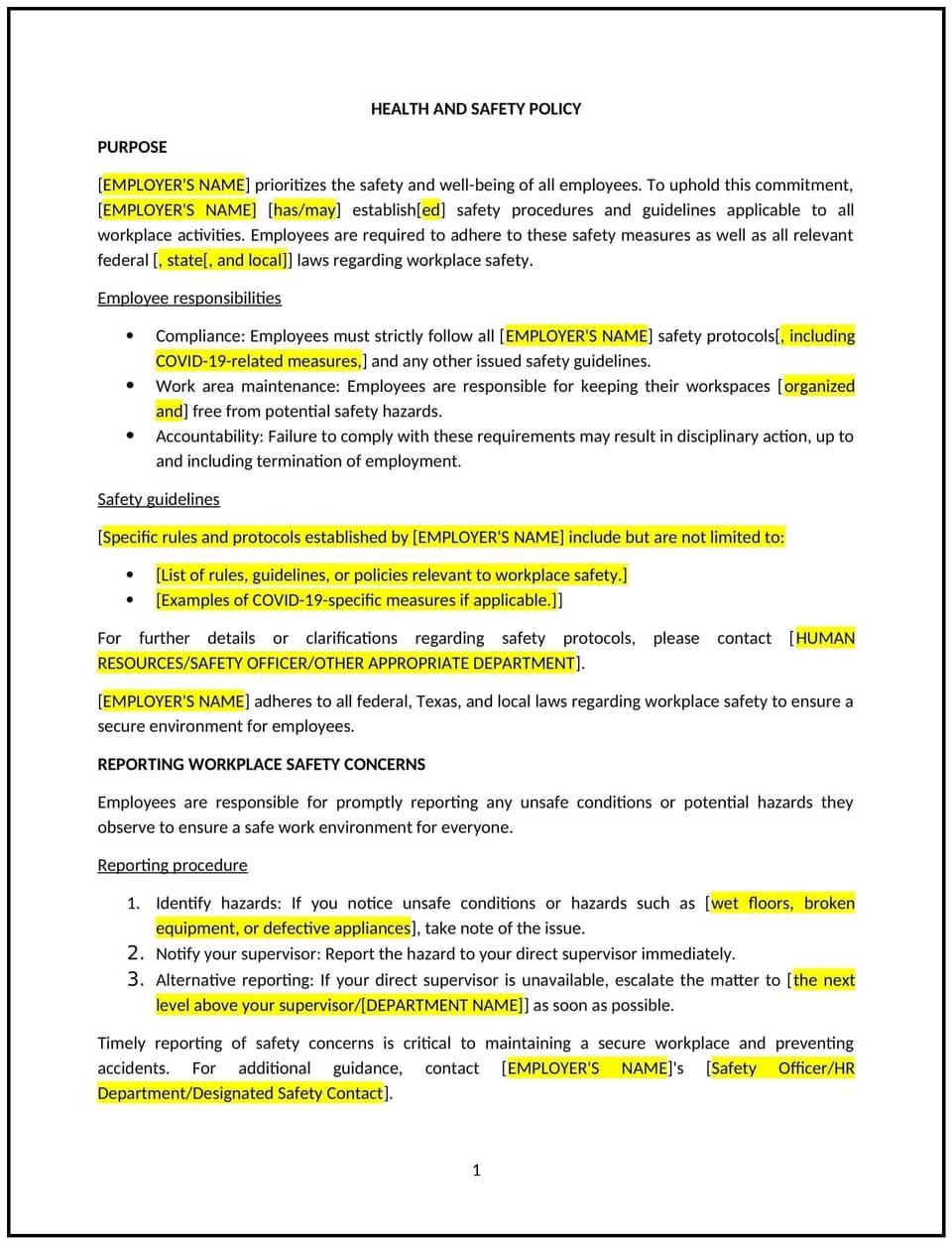Health and safety policy (Texas): Free template

Health and safety policy (Texas)
This health and safety policy is designed to help Texas businesses establish clear guidelines for promoting a safe and healthy work environment. Whether businesses are addressing workplace hazards, maintaining compliance with occupational safety standards, or providing health-related resources for employees, this policy offers a structured approach to safeguarding the well-being of all employees.
By adopting this policy, businesses can reduce the risk of workplace accidents, support compliance with Texas state laws and federal regulations, and foster a culture of safety.
How to use this health and safety policy (Texas)
- Define safety responsibilities: Clearly outline the responsibilities of both employees and management in maintaining a safe work environment, including duties for identifying hazards, reporting unsafe conditions, and adhering to safety protocols.
- Identify workplace hazards: Specify the types of workplace hazards that may be present, such as physical, chemical, ergonomic, or environmental hazards, and explain how these will be addressed.
- Set procedures for reporting safety issues: Establish a process for employees to report unsafe conditions, accidents, or injuries, and clarify the steps for addressing these concerns in a timely manner.
- Provide health and safety training: Outline the types of training employees will receive to ensure they are aware of safety procedures, use protective equipment correctly, and respond to emergencies.
- Establish emergency procedures: Define the procedures for responding to emergencies, including evacuation plans, first-aid protocols, and emergency contact information.
- Promote wellness programs: Offer wellness programs or initiatives to support the physical and mental health of employees, such as fitness programs, counseling services, or stress management resources.
- Set consequences for non-compliance: Specify the consequences for failing to adhere to health and safety policies, including disciplinary action for negligence or failure to report safety concerns.
Benefits of using this health and safety policy (Texas)
This policy offers several benefits for Texas businesses:
- Reduces workplace injuries and accidents: By implementing health and safety protocols, businesses can reduce the likelihood of accidents and injuries, protecting employees and minimizing downtime.
- Enhances employee well-being: A strong health and safety policy supports employees’ physical and mental health, fostering a positive and supportive work environment.
- Complies with legal requirements: This policy helps businesses comply with Texas state laws, federal regulations (such as OSHA guidelines), and industry standards related to workplace health and safety, reducing the risk of legal penalties.
- Improves employee morale: Employees who feel safe at work are more likely to be engaged, productive, and satisfied with their job, which can improve retention and overall workplace culture.
- Demonstrates corporate responsibility: By prioritizing health and safety, businesses enhance their reputation as responsible employers, attracting talent and fostering positive public relations.
Tips for using this health and safety policy (Texas)
- Communicate the policy clearly: Ensure all employees are aware of the health and safety policy and understand their roles in maintaining a safe workplace.
- Provide regular training: Conduct periodic training on health and safety topics, including emergency response, hazard recognition, and proper use of safety equipment.
- Monitor workplace conditions: Regularly assess the work environment to identify potential hazards and take corrective action before accidents or injuries occur.
- Encourage employee involvement: Encourage employees to participate in health and safety initiatives, report unsafe conditions, and contribute ideas for improving workplace safety.
- Review regularly: Review and update the policy regularly to reflect changes in Texas state laws, federal regulations, or company practices related to health and safety.
Q: What are the responsibilities of employees under this policy?
A: Employees are responsible for following health and safety protocols, reporting unsafe conditions, using safety equipment correctly, and participating in training sessions.
Q: How should employees report safety concerns?
A: Employees should report safety concerns to their supervisor or designated safety officer. The policy should outline the process for submitting reports and the timeline for addressing issues.
Q: What kind of health and safety training will employees receive?
A: Employees will receive training on hazard identification, emergency procedures, the use of protective equipment, and other safety protocols specific to their roles or workplace environment.
Q: What should employees do in the event of an emergency?
A: Employees should follow the emergency procedures outlined in the policy, including evacuating the premises, alerting emergency services, and assisting coworkers if necessary.
Q: How often should this policy be reviewed?
A: The policy should be reviewed annually or whenever there are significant changes in Texas state laws, federal regulations, or business operations that affect workplace health and safety.
This article contains general legal information and does not contain legal advice. Cobrief is not a law firm or a substitute for an attorney or law firm. The law is complex and changes often. For legal advice, please ask a lawyer.


